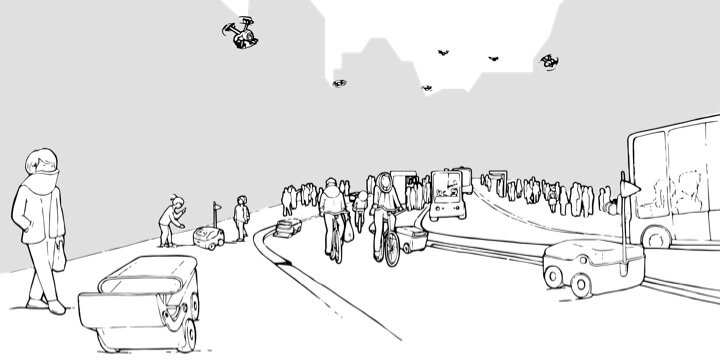Cities of Things (illustration by Maria Luce Lupetti)
Things as Citizens
2018-2019
The technological advancements in the smart city have already started to challenge the definition of what constitutes a citizen. Modern cities welcome and acknowledge their new non-human inhabitants, e.g. smart appliances associated with IoT or AI-powered autonomous vehicles, which calls upon designers to reconsider the urban interactions they facilitate. These “things”, namely data-enabled artifacts with performing capabilities (Giaccardi et al., 2016), have the potential to be contributing members of the urban community, participate in networks of social relations, establish mutuality, significance and meaning. In order words, they can “act as citizens”.
Things as Citizens project was a collaboration between me, dr. Maria Luce Lupetti (TU Delft), Prof. dr. Elisa Giaccardi (TU Delft), and Iskander Smit (info.nl/TU Delft); and was funded by the Amsterdam Institute for Advanced Metropolitan Solutions (AMS). In the project, we discussed and demonstrated how collaborations could be built between the human and non-human citizens and identified the challenges that may arise from their coexistence. We developed a workshop format for envisioning near future service robots and questioning their implications together with non-expert laypeople. Furthermore, we also employed design fiction to engage in the discussions on how things might be recognized as members of the urban community that is not here yet, but that could soon come to be.
Related Publications:
Maria Luce Lupetti and Nazli Cila. 2019. Envisioning and Questioning Near Future Urban Robotics. In Proceedings of DeSForM 2019.
Maria Luce Lupetti, Iskander Smit, and Nazli Cila. 2018. Near future cities of things: addressing dilemmas through design fiction. In Proceedings of the 10th Nordic Conference on Human-Computer Interaction (NordiCHI '18). Association for Computing Machinery, New York, NY, USA, 787–800. DOI: https://doi.org/10.1145/3240167.3240273
